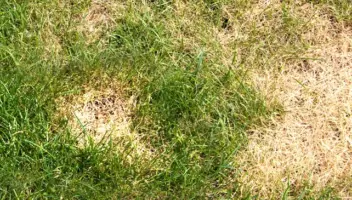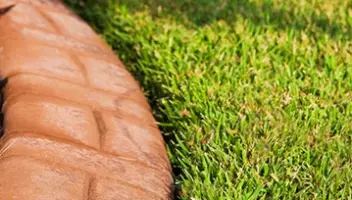When to Fertilize Your Lawn

Your lawn plays a vital role in the overall exterior of your home. It’s a great place to relax, entertain guests, and play with children. In order to keep your lawn in tip-top condition, proper lawn care is a must. The first step to maintaining your lawn involves the use of lawn fertilizer. The purpose of fertilizer is to provide your soil with the nutrients it needs to stay healthy throughout the entire growing season.
Lawn fertilizer controls and reduces weeds, promotes root and new leaf growth, assists in recovery from pest damage and foot traffic, and most importantly, replaces soil nutrients that were lost to grass clipping, volatilization, and leaching. Read on to learn about when to fertilize your lawn and how to go about doing so.
Select a Lawn Fertilizer
Fertilizers contain three of the most important macronutrients: Nitrogen (N), Phosphorus (P) and Potassium (K). On every package of lawn fertilizer, you will notice the percentage of each one of these nutrients noted. For example, a package that is labeled 21N-3P-5K consists of 21% nitrogen, 3% phosphorus, and 5% potassium.
Fertilizers that are referred to as “organic” are comprised of natural materials such as blood meal, manure, bone meal, kelp, or fish. Those that are labeled “synthetic” are made of unnatural compounds that are artificially created by chemical reactions such as potassium sulfate, ammonium nitrate, and superphosphate. While synthetic fertilizers do offer several advantages, organic fertilizers are recommended for most lawns.
Aside from releasing nutrients, organic fertilizers can improve the soil structure and make it possible for the soil to absorb the nutrients and water. In time, an organic fertilizer can strengthen your soil and crops and keep them healthy. Their slow release nature makes them easy to use and reduces your chances of over fertilizing and harming your crops. In addition, they are sustainable and very good for the environment.
[lf_ad campaign=”reviews”]
Prepare for Fertilizing
Prior to beginning the fertilization process, you must prepare your lawn. First, you should determine your grass type. Whereas warm season grasses turn brown following the first frost, cool season grasses typically remain green all year long. In some areas of the , there may be both cool and warm season grass.
After you figure out your grass type, a soil test is encouraged. A soil test will help you find out the pH level of your soil. pH level will show you the ability your grass has to use the fertilizer ingredients and inform you of what type of fertilizers is right for your lawn. A pH level between 6.0 and 7.0 is ideal for growing the highest quality grass.
Following a soil test, you should measure your lawn to find out its square footage by multiplying the length of your lawn by its width. Determining your lawn size will give you a good idea of how much fertilizer you need to purchase. Most fertilizer packages will state the amount of square meters they can cover. The majority of fertilizer bags provide between 460 and 1300 square meters of coverage.
When and How to Fertilize
Understanding when to fertilize your lawn is essential in lawn care. The timing of when to fertilize your lawn mainly depends on the type of grass in your lawn. Here are some guidelines on the ideal fertilization schedule for both warm season grasses and cool season grasses:
Cool-Season Grasses
If you’ve concluded that you live in a climate with cool-season grass, the growing season is usually in the cooler months of the spring and fall. You should fertilize lightly in the early spring and heavily in the fall. In the fall, you should start the fertilization process before cold weather arises but after the brutal summer heat has subsided.
It’s a good idea to use a special winterizer fertilizer that can help protect the grass during the winter. In the spring, you can opt for a quick-release or slow fertilizer and should begin fertilizing early in the season. Fertilization should be timed so that you use up the fertilizer before the hot weather when your grass is likely to go dormant. Keep in mind that cold-season grasses grow best when the temperature is between 15 to 20 degrees Celsius.
Warm Season Grasses
If your lawn features warm-season grasses, it is recommended that you fertilize when the grass begins turning green in the spring. The growing season for warm season grasses depends on your particular geographic location but is typical during the late spring and summer. If possible, invest in a quick-release fertilizer and make sure that your lawn fertilizer is used up before the hot summer weather arises. Warm season grasses grow at their optimal capacity when the temperature is between 25to 35 degrees Celsius.
Fertilization Process
Begin the fertilization process by setting the spreader settings to match the amount of fertilizer you’d like to apply. This information can be found on the label of the spreader or fertilizer. Next, place the spreader over a hard surface such as a walkway or driveway and fill it up with fertilizer. Lawn fertilizer should initially be spread over the lawn edges. Once the lawn edges have been completed, fertilize the main area of the lawn. Be sure to carefully follow the manufacturer’s instructions when you fertilize to avoid lawn damage.
After fertilizing, be sure to water your lawn thoroughly. Watering your lawn following the fertilization process allows the nutrients to get washed into the soil so that the lawn roots can absorb them and they don’t get washed away by heavy rainfall. When you are finished with everything, thoroughly wash your spreader, hands, and clothing.
The tips above will help you determine when and how to fertilize your lawn to keep it looking beautiful and vigorous during every month of the year. If you’d like more information on lawn care and how to keep your home’s exterior in excellent form, check out our wide selection of handy blog articles.


